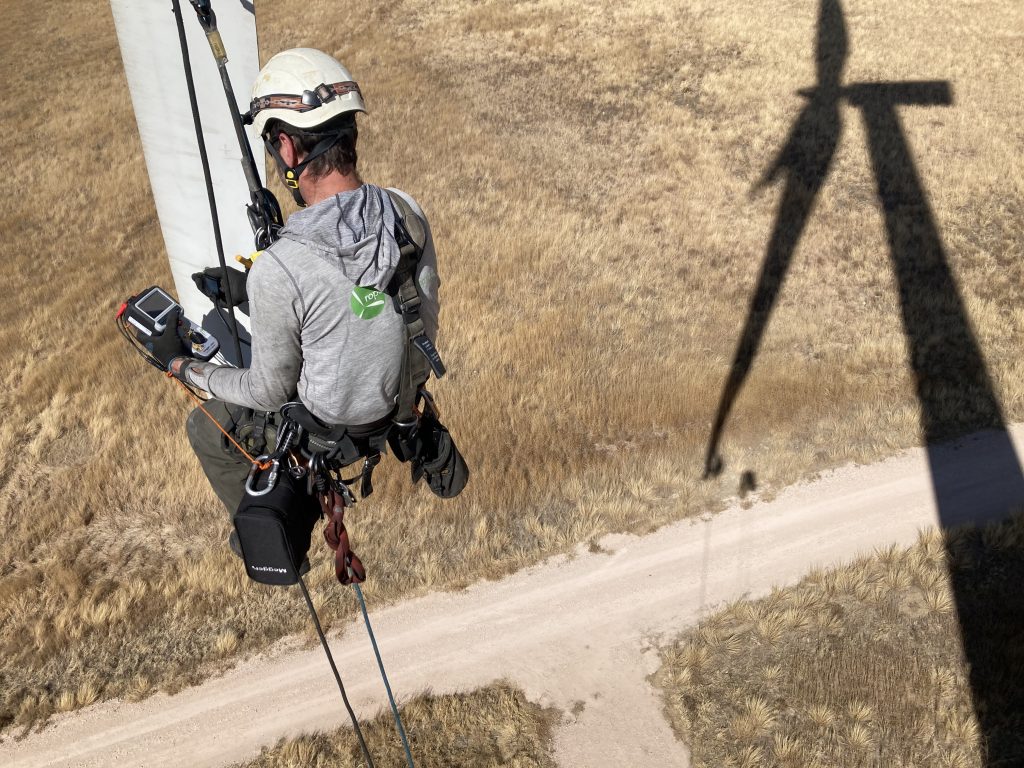Over the years, the use of wind power has created a great deal of well-paying jobs, including everything from technicians, researchers, and designers to workers on new wind-energy farms and those that create the latest wind-energy gadgets and discover the latest technology to make wind power even better. Currently, there are more than 125,000 people working in the wind industry across the United States, and that number continues to grow. According to the U.S. Bureau of Labor Statistics, wind-turbine service technicians are the fastest growing U.S. job of the decade, and with good reason.
Each year in the United States, 380 billion kW/h are generated by wind turbines that convert kinetic energy from the wind into electrical power. But what happens when these $2-million to $4-million wind turbines that stand 280 feet in the air with blades ranging in length from 40 feet to 250 feet, experience some sort of mechanical malfunction? What happens if a blade becomes damaged due to a bird strike, lightning strike, blade detachment, leading-edge erosion, or blade crack? Skilled technicians are needed to correct the problem.

These technicians, who evaluate the turbine and its blades and get the turbine back up and running, are a vital part of the process that helps to generate wind power.
Rope Partner, in Centennial, Colorado, is a provider of at-height maintenance, inspection, and performance enhancements for wind-turbine operations that require specialized access approaches. For more than two decades, the company’s WindCorps® technicians have completed several thousand projects for every major manufacturer of wind turbine, as well as for the majority of wind-farm owners across the United States. They are experts in testing these massive structures when there is a malfunction or complete failure.

Trouble with the Lighting Protection System
Recently, a client of Rope Partner’s was having an issue with its wind-turbine blade lightning protection system (LPS). This system is particularly important to a turbine because it prevents physical damage to the structure by redirecting a lightning strike from the blade to ground. If lightning strikes an unprotected blade, an explosive expansion of the air within the blade can occur, resulting in severe damage to the blade surface and downtime of the turbine. Because this system is so crucial to protecting the wind turbine, Rope Partner was asked to examine, test, and diagnose what was going on with the LPS and how it could be remedied.
Testing wind turbines can be very tricky if you don’t have the right test equipment, as they reach extremely high elevations, and their movement through the air causes ionization, which creates a target for cloud charge that can develop in the atmosphere, making the blades susceptible to lightning strikes. The only protection the blades have against these strikes is a properly working LPS.
Examine, Test and Diagnose
To figure out what the exact problem was with the LPS and why it wasn’t working properly, technicians needed to test the system while it was installed on the turbine.
The most common way to start the assessment is to test from the root of the blade to each receptor on the blade. If this test fails, then technicians try to diagnose the connectivity issue by using different test points on the blade. This not only requires a technician to test between receptors on the blade, but it also requires the technician to bring various pieces of equipment out on the blade. This is not an easy task when hauling big, bulky equipment such as an ohmmeter, voltage tester, multimeter, oscilloscopes, infrared testers, and fiber optic equipment while climbing a wind-turbine tower and going out on a rope to perform an inspection and repair.
For the technician to pick up these potential faults, what is needed is a higher test current of 1A or more. This is because blades can be up to 100 meters long and are tested tip to hub. Test leads that can reach that length must be designed with low enough resistance to not overwhelm the instrument’s capabilities and invalidate the test. Most instruments cannot be used to perform this task.
For years, Rope Partner used a Digital Low Resistance Ohmmeter (DLRO) that measured low resistance values in micro-ohms at specified currents. However, the unit they were using encountered frequent issues with setup, causing incorrect readings.
This was a problem for our techs whose primary scope is blade repair,” said Lucas Llado, vice president, business development, Rope Partner. “It is extremely important for techs to have a device that is foolproof to set up, as LPS testing is not a scope of work that is performed frequently — maybe just once or twice a month. Since LPS testing isn’t performed often, it is important to have a device that is easy to use and completes the task accurately. It is also essential to have a reliable device when an open circuit is found.”

A Better Testing Tool
With technicians getting frustrated, and results not being what they should be, Rope Partner decided to look for a new tester. With industry references and doing some research on its own, the company learned about the DLRO2 from Megger.
“This unit is easy for a single technician to handle while out on the rope during inspection,” Llado said. “Previous models we used were big and bulky and required more than one person in the air.”
Given the small footprint of the DLRO2 and the ability to use long test leads with it, all LPS testing can be performed quicker and easier with one tool.
The compact, handheld design of these 2A low resistance ohmmeters provides relative high output, accuracy, and repeatability. They fit easily in a toolbox and be used in tight and hard-to-reach spaces.
When a technician has limited space while hanging from a rope, having a tester that has a small footprint and is lightweight greatly improves workflow.
“Being able to just plug the leads in with banana connectors helps to make setup easier and more efficient,” Llado said.
“This unit also makes attaching leads with banana connectors much easier than trying to attach with lugs that often come loose when leads are moved.”
The unit can also display the results of the last three readings, take timely photos, and has the ability to take one photo to be included with the report.
“By using the DLRO, we were able to detect the non-conductivity and realized that the LPS was damaged,” Llado said. “Once this was identified, we were able to repair it quickly.”
LPS systems are tested in accordance with the IEC 61400-24 standard. By partnering with these clients and using the correct tools, while applying safe, cost-effective, and environmentally appropriate solutions, Rope Partner has been successful in reducing turbine downtime, increasing production-based availability as well as the lifespan of its clients’ turbines.
























